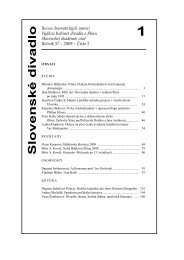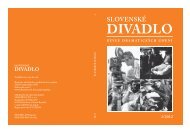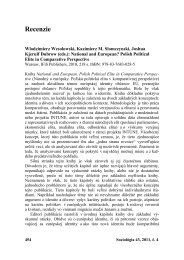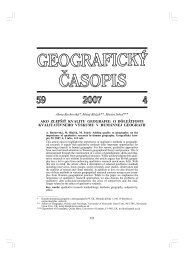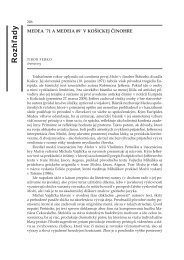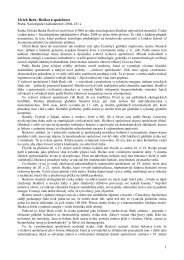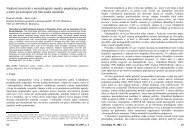NATURE IN MAORI METAPHOR - SAV
NATURE IN MAORI METAPHOR - SAV
NATURE IN MAORI METAPHOR - SAV
You also want an ePaper? Increase the reach of your titles
YUMPU automatically turns print PDFs into web optimized ePapers that Google loves.
ASIAN AND AFRICAN STUDIES, 5, 1996, 1, 14–27<br />
<strong>NATURE</strong> <strong>IN</strong> <strong>MAORI</strong> <strong>METAPHOR</strong><br />
Viktor KRUPA<br />
Institute of Oriental African Studies, Slovak Academy of Sciences,<br />
Klemensova 19, 813 64 Bratislava, Slovakia<br />
Metaphor is known to occur in all languages of the world and its appearance in speech is<br />
stimulated by factors inherent in the so-called problem situations, in the activity known as<br />
problem solution. Therefore we can distinguish poetic and cognitive metaphors. A predominantly<br />
cognitive basis, for example, gives birth to metaphors in the speech of children, in terminology<br />
(especially at the forefront of science) and in the early phases of the existence of<br />
pidgins. Here we have to do with lexical metaphors that on the whole serve practical purposes<br />
of communication and their basis is chiefly cognitive, perhaps with the exception of<br />
stylistically marked expressions where emotional factors are in the foreground.<br />
The poetic metaphor is largely dominated by emotional factors and may be<br />
described as a manifestation of additional linguistic creativity, that is creativity<br />
that exceeds or transcends the standard level of creativity hidden perhaps behind<br />
most if not all utterances (if speech activity is defined as generating utterances<br />
from a ready-made inventory of units by means of the application of a set of<br />
rules that are given in advance).<br />
Poetry is an ideal medium for extra creativity the level of which may gradually<br />
rise because what has been achieved before can and ought to be surpassed<br />
in order to deserve the label of being creative.<br />
Creatively valuable conceptual associations or configurations expressed in<br />
metaphors correlate with hidden, profound and/or surprising links. The functions<br />
of cognitive and poetic activities diverge, and the aim of metaphorical<br />
creativity in poetry is to achieve adequate (and individual) self-expression and at<br />
the same time to arrest the attention of the recipient as well as to produce in him<br />
a desirable reaction to the poetic work. This holds for non-anonymous poetry.<br />
I think we can accept Embler’s view that poetry is an expression of the internal<br />
world of the poet through the external world (Embler 1966). Thus especially<br />
human feelings and moods are very frequently described via images borrowed<br />
from nature (e.g. storm of excitement), just as admiration, joy, sorrow, loneliness,<br />
desire.<br />
In non-anonymous poetry the highest ambition of the poet is to be original<br />
and therefore unusual metaphors, metaphors that stimulate thought on the part<br />
of the recipient and provoke his creative approach during the process of inter-<br />
14
pretation, are valued. In the lexicon, however, elementary and more straightforward<br />
and conventional metaphors are preferred (often based upon human<br />
anatomy, natural phenomena, social organization, family, etc.).<br />
Traditional poetry ought to be carefully distinguished from non-anonymous,<br />
individual verse. The former tends to be essentially stereotypical and canonized.<br />
A fairly restricted inventory of elementary metaphors displays a high frequency<br />
of occurrence in folk poetry. Here metaphor strives to carry out a comparison<br />
with the conventionally accepted standard of the society. This gives us a fairly<br />
reliable insight into the naive “philosophy” of the people concerned and into<br />
their system of values and attitudes to their surroundings and nature.<br />
There are other differences between traditional and non-anonymous poetry<br />
(one important remark: In New Zealand there is traditional Maori poetry written<br />
by known authors since the early 19th century). The author of traditional poetry<br />
usually borrows his metaphorical images from his immediate environment with<br />
which all recipients are familiar so that there are no serious problems involved<br />
in their process of interpretation. Since traditional poetry is passed from generation<br />
to generation orally, variation is known to occur but generally the degree of<br />
such variation tends to be low.<br />
Another typical feature of Maori traditional poetic metaphor is its heavy reliance<br />
on nature as the main source of poetic imagery. This, by the way, seems to<br />
be its universal feature throughout the world. There is a question, however, to<br />
what extent this could be interpreted as a confirmation of the non-alienation of<br />
the traditional poets from their natural environment and of their individual involvement<br />
with nature. This attitude to nature seems to be mediated through<br />
their religion.<br />
In Maori poetry of the pre-contact era the feeling of unity with the cosmos<br />
was obviously very strong. Maori religion is, after all, a natural religion. Heaven<br />
and Earth were parents of the gods and these gods were identified with particular<br />
natural phenomena: Tane with the trees and forests (as well as with<br />
birds), Rongo with cultivated plants, Tangaroa with the sea and its creatures,<br />
Tawhirimatea with the wind, Tuu with the man and war, etc.<br />
Maori examples confirm the assumption that the cultural orientation of a society<br />
finds its reflection in the inventory of canonical metaphors.<br />
A careful investigation of the representative selection of Maori traditional<br />
poetry published under the title Nga Moteatea (1959) betrays the importance of<br />
the sea and everything linked to it. Additional examples of both poetic and lexical<br />
metaphors are quoted after M. Orbell’s book The Natural World of the Maori<br />
(Orbell 1985) while the bulk of the lexical metaphors comes from the Dictionary<br />
of the Maori Language by H. W. Williams (Williams 1957).<br />
The sea (unlike the land) was always regarded as a threatening, strange and<br />
dreadful element and this finds manifestation in metaphorics too. There was a<br />
kind of war between the children of the land and those of the sea. That is why<br />
fishing was linked with various rituals and observances and women were not allowed<br />
to go fishing. People conquered in war are often spoken of as fish caught<br />
in a net, and in the love poetry a woman may be a canoe and her lover a paddler<br />
15
(Orbell 1985: 135). In the 19th century a number of sayings identified the Maori<br />
with the land and the encroaching Pakehas with the sea, or sea winds: Inaianei<br />
kua haa te haahaa tai “Now the sound of the waves has gone far inland”. The<br />
ebb tide was associated with misfortune. A warrior takes leave of his dying comrade<br />
with these words:<br />
Haere ra, e tama e! Moou te tai ata,<br />
Mooku te tai poo!<br />
Farewell, friend! The morning tide is for you,<br />
The evening tide will be for me!<br />
(After Orbell 1985: 138)<br />
Poet’s tears were often likened to crashing waves. And when the mourning<br />
has been done, he is singing:<br />
Kaati te tangi, aapoopoo taatou ka tangi anoo.<br />
Aapaa ko te tangi i te tai, e tangi roa, e ngunguru tonu.<br />
We have cried enough, for soon we will cry again.<br />
It is not like the crying of the waves, which ever cry, ever sound.<br />
This, by the way, proves that the poet is aware of the difference between crying<br />
of human beings and waves.<br />
The most frequent metaphorical image is represented by the key word ika<br />
“fish”. Most human “fish” were the victims of warfare. Any person who crossed<br />
the path of a war party must have been killed... and such a person was called he<br />
maroro kokoti ihu waka “a flying fish that cuts across the bow of a canoe”. The<br />
first enemy to be slain was maataaika “the first fish”. Ika, “fish”, occurs, e.g.,<br />
in the following metaphorical expressions: He ika ano au ka haehae “A fish I<br />
am ripped in pieces”; Kai parahua ai te ika ki te mounu “A fish nibbles at the<br />
bait”. While the former is readily accessible through the lexicalized meaning of<br />
ika as victim, the latter metaphor refers to a lover who does not take his mistress<br />
too seriously. A slightly different prototypical meaning of ika “fish” is contained<br />
in the following metaphor: He mea i motu mai i te waha o te ika “Scarcely<br />
escaped from the mouth of the fish”, meaning really “He barely escaped from<br />
death”. Here death is metaphorized as te waha o te ika “the mouth of the fish”.<br />
The metaphorical expression Ko he ika whakawera no roto i te kupenga “You,<br />
the most combative fish in the net” fuses the unfavourable shade of meaning of<br />
ika (“victim” in general) with the image of a wriggling fish helpless in the fisherman’s<br />
net. Fish may also be specified, e. g., as kaharoa, namely in the<br />
metaphor tautenga o te kaharoa “the kaharoa harvest” where tautenga ought to<br />
be understood as “hauling ashore the nets, and scaling, gutting, drying and<br />
roasting the victims killed in the battle”, which is a treatment similar to that of a<br />
fish. The dead chief Te Heuheu is described metaphorically as Koe ika pawhara<br />
na te atua, as a “disembowelled fish offered to the gods”. In another verse the<br />
16
image of a disembowelled fish, i.e., ika tuaki, is complemented with that of a<br />
stray fish or he ika pakewha. Sharks were seen as fighters and chiefs killed in a<br />
battle as stranded whales. Pakake “whale” is a metaphor for chiefs and kakahi<br />
“whale” may be metaphorically used for the beloved person, e.g. in the verse<br />
Tena te kakahi ka tere ki te tonga “Verily their whale has drifted to the south”.<br />
Enemies, on the other hand, could be compared to small and harmless fish.<br />
Other sea creatures are sometimes metaphorized. Thus kekeno “seal” in a derogative<br />
way symbolizes a woman who seduces men; A chief successful in battle<br />
is called he honu manawa-rahi “a great-hearted turtle”.<br />
The kingfish could also be regarded as a chief and because red was a highly<br />
valued colour, red-eyed mullet could be a description of a chief (cf. Orbell 1985:<br />
146).<br />
Many sea creatures were associated with particular habits and characteristics.<br />
Slander and malicious gossip could be likened to the dangerous sting of the<br />
sting-ray.<br />
A traveller is “like the garfish” (ihe) which moves about fast on the surface<br />
of the sea.<br />
The butterfish is a night creature and thus someone committing murder in<br />
the dark was “a butterfish that feeds at night” (he rarii kai po).<br />
Obstinate warriors were like mussels or paua clinging tightly to rocks or<br />
crayfish that keep to their holes (Orbell 1985: 146–147).<br />
Karoro “seagulls”, kawau “shags” and toroa “albatrosses” are likewise part<br />
of the marine world, cf. the expression karoro tipi one “startled beach sea-gulls”,<br />
Kawau aroarotea, ka tu tenei kei te paenga i o riri “The white-breasted shag has<br />
come and gazes on your many fields of battle” where the white-breasted shag is<br />
an omen of death, as is the paenga toroa “a stranded albatross”.<br />
One of the favourite images referring metaphorically to someone left alone<br />
and suffering is that of a canoe (waka) that may be shattered or overturned. Cf.<br />
the following examples: He mea nei hoki au ka pakaru rikiriki te waka ki te<br />
akau “I am a canoe shattered to fragments on the breakers”; He waka tenei au<br />
ka huripoki “I am now a canoe overturned”; Tia te tinana, he waka pakaru kino<br />
“Age will come upon me, a derelict canoe”.<br />
To describe a situation of helplessness, tawhaowhao or maero “driftwood”<br />
may be employed, e.g. Ka whanatu, ka haere, Hei karoro tipi one, Hei tawhaowhao<br />
paenga tai “Arise, go forth and be As startled beach sea-gulls, Or as<br />
driftwood from the sea; He maero au nei “Like flotsam am I”.<br />
Sea as such may undergo metaphorization reminiscent in some ways of mythology,<br />
as in the expression Kei te whaonga o te maara na Tangaroa “Put in the<br />
field of Tangaroa”, in other words drowned in the ocean.<br />
The canoe is often metaphorized as a lover who obeys the whims of his/her<br />
partner or as an unreliable partner but these metaphors are mentioned here only<br />
briefly because the canoe is not a natural object even if it is directly linked to<br />
sea, cf. the following examples: Nau te waka nei he whakahau ki te awa “I<br />
heeded your every wish like your canoe by the river”; E mahara iho ana, he<br />
waka ka urutomo, He waka he ika rere ki Hikurangi ra ia “Me thought the canoe<br />
17
was securely moored, The canoe, alas, became a flying fish to Hikurangi yonder”.<br />
Sea may be personified as crying, e.g. E tangi haere ana nga tai o te uru<br />
“The waves of the western sea are moaning” or, in very much the same spirit,<br />
Whakarongo ki te tai e tangi haere ana “Listen to the tides lamenting as they<br />
flow”.<br />
Wind is another element that undergoes metaphorization in Maori traditional<br />
poetry and it sometimes produces negative associations: Haere ra, nga rata<br />
whakaruru hau ki muri “Farewell, o thou sheltering rata from the north wind”.<br />
Tears are often represented as rain or deluge, e.g. Ko au ki raro nei riringi ai te<br />
ua i aku kamo “Whilst I here below pour forth a deluge from mine eyes”.<br />
Birds of all sorts were a kind of mediators between land and skies, they could<br />
freely move about and above and thus were qualified to be messengers of gods<br />
or spirits. Therefore they were metaphorized predominantly for their positive<br />
qualities.<br />
He kootuku rerenga tahi “A white heron of a single flight”. An orator may<br />
honour a distinguished visitor by comparing his visit to that of a white heron:<br />
such an important man comes as seldom as that bird.<br />
The white heron could represent the male, just as the huia, another remarkable<br />
bird, could be associated with the female. Because herons stand motionless<br />
in the water and await their prey, a proverb spoke of he kootuku kai whakaata, “a<br />
white heron that feeds upon its reflection”. William Colenso explains that this<br />
proverb was used of a chief who concerned himself with feeding his guests and<br />
of one who quietly and courteously awaits the arrival and sitting of others to<br />
their repast before he eats his own food. Such manners were a sign of good birth<br />
(Orbell 1985: 207–208).<br />
Bitterns were expressing their loneliness and melancholy; a woman unhappy<br />
in love might view herself as a bittern:<br />
Me he huuroto au kei roo repo,<br />
Me he kaaka, e whakaraaoa ana!<br />
I am like a bittern in the swamp,<br />
A bittern with its choking cry!<br />
(After Orbell 1985: 208–209)<br />
The singing of birds at dawn was a sign of the triumph of light over darkness,<br />
and it was associated with oratory. Departed chiefs might be praised as taku<br />
manu whakaoho i te ata “my bird that woke the dawn”.<br />
Someone with bad manners could be said to have been hatched by a bird, and<br />
a babbler might be accused of making as much noise as a baby bird. Usually,<br />
however, images based upon birds were favourably appreciated. Brave warriors<br />
were “flapping birds” and “stubborn birds”.<br />
Birds’ nests are metaphorized (as elsewhere in the world) as birthplace or<br />
safe abode. Young mothers lived with their newly born children in a separate hut<br />
18
termed a nest house. A talkative person was sometimes labeled as kaakaa, i.e., a<br />
large gregarious parrot, as he kaakaa waha nui “a big-mouthed parrot”; boasting<br />
enemies were chattering kaka who would soon meet their fate.<br />
Eloquent orators and accomplished singers were said to sound like the tui<br />
and the bellbird (koopara).<br />
Bellbirds are restless creatures and therefore suitable to characterize a frivolous<br />
woman (he koopara kairerere).<br />
A chief whose death was mourned in a lament might be called by the poet he<br />
huia tuu rae “a huia plume on my brow”, and in love songs a sweetheart was<br />
sometimes te huia kai-manawa “the huia that consumes my heart”.<br />
Strangely enough, the morepork (ruru), as elsewhere in the world, was associated<br />
with the night and with spirits of ancestors. Its presence was taken as a<br />
warning of a death in someone’s family.<br />
According to George Grey, the hawk was a symbol for a great chief and the<br />
falcon for a treacherous, cruel man. High chiefs might be spoken of as white<br />
hawks, cf. the saying Me haere i raro i te kahu koorako, “Travel under the protection<br />
of a white hawk”: which meant a good reception for everybody.<br />
Cosmic imagery is by no means exceptional in Maori poetry and even rhetoric<br />
abounds in cosmic metaphors. Many of them tend to be applied to chiefs,<br />
especially to their death. Thus the verse Naana i horo te whetuu te maarama “It is<br />
him who swallowed the stars and the moon” refers to fights where the warriors<br />
are identified with the stars (whetuu) and the chiefs with the moon (maarama)<br />
when they were killed by the Tuuhourangi. When a warrior or a chief dies, the<br />
poet declares I whati ai te maarama “The moon was broken”. The same meaning<br />
is delivered by the metaphor I makere iho ai te tara o te maarama “The point of<br />
the riven moon has fallen” as well as by an analogous expression Kaa whati raa,<br />
ee, te tara o te maarama “Alas, severed now is the point of the crescent moon”.<br />
In the forest the Maori saw a hierarchy of trees similar to that in human society,<br />
and they distinguished the most stately ones as raakau rangatira, “chiefly<br />
trees”, from the common trees, the so-called raakau ware. The class of the chiefly<br />
trees includes above all the tootara, kauri, kahikatea, rimu, rata, and maire.<br />
A tree may symbolize a tribe, but it is usually viewed as representing an individual;<br />
a distinguished person who died was metaphorized as a majestic tree in<br />
poetry. Cf. the following poem by Te Wharerangi:<br />
Ehara i te tangata koe, maahuri tootara!<br />
He waa kahikatea i rutua e te hau,<br />
Pae ana ki te one, ngaa tuakirikiri i waho Wairehu.<br />
You were not a man, you were a young totara!<br />
A Kahikatea forest uprooted by a gale<br />
Lies cast up on the sand, on the gravel beaches beyond Wairehu.<br />
The noblest of all trees was the totara with its red wood and thus fitting for<br />
chiefs. Since the best timber is found within a forest, not on its borders, a chief<br />
19
was likened to a totara growing inside the woods – his proper place is in the<br />
midst of his people, says M. Orbell.<br />
Cosmic metaphor may be used to underline the brilliancy of someone’s eyes,<br />
e.g. Ko aaku mata i rehu, e whakawhetuu mai ana roto “My misty eyes are quite<br />
bedimmed and shine forth from within like stars”.<br />
The philosophical basis of cosmic metaphor derives from mythology. This is<br />
the case of the following verse: He maarama kia mate, kaa ea mai ki runga i ee<br />
“Thou art the waning moon which dies, later again is seen on high”.<br />
Other kinds of metaphor witness to the imaginative variety of Maori traditional<br />
poetry. The verbal expression taakohutia “being wrapped in mist” refers<br />
to sorrow; rima “seaweed” may refer to internal emptiness, e.g. Waiho au kia<br />
pooaha ana, he rima puka kei te aakau “So let me remain empty, (like) the porous<br />
seaweed on the shore”; poo “night” hints at death, cf. te tira o riri poo “the<br />
company of the battle of night”, i.e. the dead ones; and huka moana “sea foam”<br />
is a metaphorical reference to something valueless.<br />
Maori poetry abounds in sequences of metaphors that characterize their tenor<br />
from several points of view. This perseverance of emotional effect makes the semantic<br />
interpretation of verse easier. A dead chief imay be wept over in the following<br />
way: Kaa whati raa, ee, te tara o te maarama (1), Taku ate (2) hoki raa,<br />
taku piki kootuku (3), Teenaa te kaakahi (4) kaa tere ki te toonga “Alas, severed<br />
now is the point of the crescent moon (1), You were my heart (2), my kotuku<br />
plume (3), Verily the whale (4) has drifted to the south”. It is usually deep sorrow<br />
that provokes such an outburst of emotions as the next poetic sequence:<br />
Tirohia mai au he ika tuaki (1), Paenga toroa (2) he koroirirangi, He ika<br />
pakewha (3) ’hau na Rehua, e tama ma ee! He huka moana (4), paringa-a-tai<br />
akahu ki te whanga “Look and see me here a disembowelled fish (1), A stranded<br />
albatross (2), tossed by the whirlwind; A stray fish (3) of Rehua am I, o youthful<br />
ones! Like the sea foam (4), faintly seen at the inlet”. A mournful seaside scenery<br />
is metaphorically applied to the mood of loneliness and old age as follows:<br />
Tia te tinana, he waka pakaru kino (1), kaa ruha (2) noa au ki te aakau (3), ee<br />
“Age will come upon me, like a derelict canoe (1), discarded (2) I shall be upon<br />
the strand (3), ah me.”<br />
Metaphorical and periphrastic expressions abound in Maori ritual and rhetoric<br />
(called metaphorically te kai a ngaa rangatira “the food of chiefs”), that rank<br />
among the finest in the whole of Oceania. The motivating mechanisms behind<br />
them are euphemism, eulogy and mythical inspiration.<br />
Death is sometimes described as haere ki tua o te aarai “to go beyond the<br />
veil or screen” or te uurunga tee taka, te moenga tee whakaarahia “the pillow<br />
which does not slip, the bed from which there is no arising”. Just as easy to decipher<br />
is the expressiom te ringa kaha o aituaa “the strong hand of misfortune”,<br />
or even te iwi wahanguu i te Poo “the silent people of the Night” meaning the<br />
deceased ancestors.<br />
Not a few metaphorical expressions can only be properly understood within<br />
the conceptual framework of Maori mythology where an outsider can hardly<br />
separate natural images from mythological beliefs. In the expression Kua hinga<br />
20
te tootara o te wao nui a Taane “A totara tree of the great forest of Tane has<br />
fallen down”, mankind is metaphorized as a forest (of which, as we know, Tane<br />
is a god) and the expression itself can be translated as “The great chief has<br />
died”. Burial is often described as ngaro ki te koopuu o Papatuanuku “having<br />
disappeared within the bowels of the Mother Earth” – perhaps as a hint at the<br />
unsuccessful attempt of Maui to enter the bowels of the goddess Hine-nui-tepoo<br />
and thus, reversing the normal procedure, to gain immortality for mankind –<br />
or simply as a return to the Mother Earth.<br />
And yet death is not interpreted as an event leading to an irrevocable separation.<br />
Just as visitors to the tribal house (whare whakairo) were greeted by their<br />
hosts as ngaa kanohi ora o ngaa tiipuna “the living faces of the ancestors” or as<br />
ngaa moorehu o te hunga mate “the survivors of the dead”, those who had died<br />
were present at the moment when their descendants were entering the tribal<br />
house. This house was viewed as the ancestor’s body and the entry was equated<br />
to the return to the cosmogonical past. The past could not be isolated from either<br />
present or future and the unity of the living with the dead was repeatedly emphasized.<br />
Even the cosmogonical parents, Rangi (Heaven) and Earth (Papa), were<br />
ever present with each generation, for the creation was no closed or terminated<br />
process. The God Tane who as the only one from the circle of divine brothers<br />
managed to push their heavenly father Rangi to its proper position, away from<br />
mother Earth (Papa), is actually identical with the trees that incessantly grow<br />
and (perhaps) are supporting the sky with their very heads and limbs. Clouds<br />
were regarded in Hawaii as bodies of the god of crops (and rain, of course) Lono<br />
and likewise, rain was interpreted as the tears of Heaven: Uwe ka lani, ola ka<br />
honua “When Sky weeps, Earth lives”.<br />
Nature is massively represented in the Maori lexicon as documented by the<br />
W. H. Williams’ dictionary, the most exhaustive lexicographic description of the<br />
language (Williams 1957). About half of all lexical metaphors in Maori take<br />
their vehicles from the realm of nature and majority of them come from the domain<br />
of fauna, flora or animal and plant anatomy.<br />
Just as in poetry, sea animals take up the first position in metaphorical productivity:<br />
angaanga /anga shell > elder, chief<br />
ika fish > prized possession, fighting man, warrior, victim<br />
ika a Whiro /Whiro god of evil and darkness/ > old, tried warrior<br />
ika toto nui /toto blood, nui great/ > a chief of high birth<br />
ika nui a god (syn. with atua)<br />
ika paremo /paremo to drown/ > a victim slain to propitiate<br />
Tangaroa /god of the ocean/<br />
ika takoto a Tiki /takoto to lie down, Tiki god of creation/ > a corpse<br />
ika purapura /purapura seed/ > human victim buried during erection of a house<br />
ika wheua /wheua bone, to be firm/ > main range of hills<br />
ika iri /iri a spell/ > object of a love charm<br />
21
Ika Wheua o te Rangi Bone Fish of the Sky = Te Ika o te Rangi Fish of the Sky =<br />
Ika Roa Long Fish > The Milky Way<br />
Te Ika a Maaui Maaui’s Fish > North Island<br />
kaakahi a whale > large porpoise chief<br />
kekeno sea-lion > chief<br />
kina sea-urchin, sea-egg > a globular calabash, stomach distended with food<br />
ngohi fish > victim, person slain in battle<br />
nguu sepia, squid > a person unable to swim (?), ghost, silent, dumb, speechless<br />
pae wai a species of eel > person of importance<br />
paraaoa sperm whale > chief, well born, aristocratic<br />
ika paremo /ika fish, paremo drowned/ > a human victim killed to secure good<br />
luck<br />
poorohe > a large species of mussel, chief<br />
taniwha a fabulous monster, shark > chief, prodigy<br />
unahi o Takero /unahi scales, Takero a fish/ > shooting stars<br />
unahi roa /roa long/ > ignis fatuus, comet<br />
Te whai a Titipa /whai sting-ray/ > The Coalsack<br />
haku kingfish, Serida grandis > chief<br />
Another very rich productive domain is that of birds or flying creatures:<br />
huia Heteralocha acutirostris, a rare bird, the tail feathers of which are prized as<br />
ornaments, its feathers > anything much prized<br />
kaaeaea bush hawk, to act like a hawk fool > to look rapaciously, wander (as the<br />
eyes)<br />
kaahu hawk, harrier > chief, kite for flying<br />
kawau pu Phalacrocorax carbo, shag > a chief<br />
koohanga nest > birthplace, fort<br />
kahu koorako /an old hawk with light plumage/ > chief<br />
kootare kingfisher > beggar, sponge<br />
kura red, glowing, ornamented with feathers > precious treasure, valued possession,<br />
darling, chief, man of prowess, knowledge of karakia, ceremonial<br />
restriction<br />
manu bird > person held in high esteem<br />
manu kura /kura something precious/ > chief, leader in council<br />
manu a Tane /Tane a deity/ > man<br />
manu a Tiki /Tiki a deity/ > man<br />
manu waero rua /waero tail, rua two/ > violent wind<br />
moho Notornis hochstetteri, blockhead, trouble, stupid<br />
muri manu /manu bird/ > inferior or secondary wife<br />
piipii /pii young, of birds/ > the young fighting men of an army<br />
pokai tara /pokai swarm, flock, tara a bird, thorn/ > band of warriors<br />
weu a tuft of hair, feather > chief<br />
22
The domain of animal anatomy is dealt with separately:<br />
angaanga /anga shell, husk, skeleton, stone of fruit, vessel; angaanga head/ ><br />
elder, chief<br />
hiku tail of a fish/reptile > rear of an army on march/company of travellers, tip<br />
of a leaf, headwaters of a river, eaves of a house; hiku tau (literally the tail of<br />
the year) end of a season; hiku toto (literally the tail of blood) expedition to<br />
avenge murder; hiku wai (the tail of water) source of a stream, light early<br />
rains.<br />
The domain of plants including trees is underrepresented:<br />
kahika Podocarpus excelsum (white pine), chief, ancestor<br />
kiokio a fern, palm lily the moon on the 26th day lines in tattooing<br />
tumatakuru a thorny shrub, spear-grass > to show consternation, be apprehensive<br />
harore an edible fungus growing on decayed timber > shell of the ear<br />
Plant anatomy is a conceptual model quite frequently employed by lexical<br />
metaphors:<br />
hua fruit > egg, roe, product, progeny, abundance, number, to be full (of a<br />
moon), wax<br />
kaapeka branch of a tree > branch of a river<br />
karihi stone of a fruit, kernel > testes<br />
kakau stalk of a plant > handle of a tool<br />
kau ati the piece of wood to produce fire > chief, man of importance<br />
kore kaupeka /branchless; kaupeka branch/ > a childless person<br />
kaawai shoot, branch (of a creeping plant) > pedigree, lineage; tentacles of a<br />
cuttlefish, loops or handles of a kete, strand in plaiting<br />
koouru o te matangi /koouru top of a tree, head of a river; matangi wind/ > first<br />
puff of a breeze<br />
mahurangi > flesh of a kumara > used to denote importance; applied to persons,<br />
food, etc.<br />
manga branch of a tree > branch of a river, brook, rivulet, watercourse, ditch,<br />
snare<br />
miha young fronds of fern > distant descendant<br />
more tap-root > cause, extremity, promontory; bare, plain, toothless, blunt<br />
parito centre shoot or heart of endogenous plants > offspring<br />
peka branch, faggot, fernroot > chief<br />
wana to bud, shoot > ray of the sun<br />
wanawana spines, bristles > fear, thrill, fearsome, awe-inspiring, to quiver, shiver,<br />
trill<br />
whaa leaf > flake, feather<br />
mae withered > languid, listless, struck with astonishment, paralysed with fear,<br />
etc.<br />
23
Natural elements (fire, water, sea, wind, etc.) are far from rare in lexical<br />
metaphors, obviously because of their ability to be active:<br />
ahi tere /ahi fire, tere swift, active, hasty/ > causing discord<br />
aho rangi /aho radiant light, cf. also above, rangi heaven, sky/ > teacher of high<br />
standing in the school of learning<br />
amai swell on the sea > giddy, dizzy; aamaimai nervous<br />
aawangawanga /awanga SW wind/ uneasy in mind, disturbed, undecided, distress<br />
hau wind, air, breath, dew, moisture > vital essence of man, of land, etc., food<br />
used in ceremonies, portions of a victim slain in battle, used in rites to ensure<br />
good luck<br />
huene swell of the sea > to desire<br />
huka foam, froth, frost, snow, cold > trouble, agitation<br />
whakakaa /kaa to burn, take fire/ > to incite, inflame<br />
kahu kura rainbow > butterfly, a garment<br />
kare ripple > lash of a whip, object of passionate affection, to long for, desire<br />
ardently; kakare agitated, stirred, emotion, agitation<br />
karekare surf, waves > agitated, disturbed, eager<br />
koohengi(hengi) breeze, light wind > yearning, feeling (for absent friends)<br />
komingo to swirl, eddy > to be disturbed, be in a whirl, agitate<br />
koomingomingo whirlpool > to be violently agitated<br />
koorehu haze, mist, fog > regret, disappointment<br />
kootonga cold south wind > misery<br />
maapuna to well up, ripple, sway, undulate, form a pool > to grieve, sigh<br />
whakamarama /marama moon/ > crescent-shaped top of a ko<br />
marau meteor, comet > raiding party<br />
mumu baffling, boisterous wind > valiant warrior<br />
muri breeze > to sigh, grieve<br />
nawe to be set on fire > to be kindled or excited (feelings)<br />
pahunu fire, to burn > anxiety, apprehension<br />
pakiwaru settled fine weather > person of high birth<br />
paoa smoke > gall, bitterness (e.g. tupu te paoa ki tona ngakau “smoke is rising<br />
to his heart”)<br />
ahi paaraweranui widespread fire > war<br />
pii source, headwater > origin<br />
poo > night, season > place of departed spirits<br />
whakapoo to darken > to grieve<br />
poko to go out, be extinguished > to be beaten, defeated<br />
pouri dark > sorrowful, sad, distressed<br />
puna spring of water, hole, oven > wife, ancestor<br />
rangi heaven, upper regions, sky, weather, day, period of time > stanza, air, tune<br />
head, chief, sir, seat of affections, heart<br />
roku to wane (of the moon) > to grow weak, decline<br />
taahuna a tara /shoal, sandbank, tara tern/ > an assemblage of chiefs<br />
taahurihuri to rock (like a canoe at sea) > to be perturbed, be at a loss<br />
24
tai sea > anger, rage, violence<br />
tai tamatane /tai sea, tamatane virile/ > the sea on the west coast<br />
tai tamawahine /tamawahine feminine/ > the sea on the east coast<br />
tai /in phraseology/: Ka hura te mata o te tai “The tide has begun to flow”; Ka<br />
ara te upoko o te tai “same meaning as above”; Ka paa te upoko o te tai “The<br />
tide is at its highest”; tai whawhati rua /whawhati be broken, rua two,<br />
double/ > error in reciting a spell<br />
take root, stump, base of a hill > cause, reason, means, origin, beginning, chief,<br />
head of a hapu or iwi<br />
tarakaka southwestern wind > fierce, boisterous<br />
taawhati to ebb > to die<br />
taumata okiokinga /taumata resting place on a hill, okiokinga resting/ > a great<br />
chief<br />
tore to burn > to be erect, inflamed<br />
toretore rough sea > rough, bad, unpleasant<br />
tua o rangi /rangi sky, day/ > distant time, past or future<br />
Tuahiwi o Ranginui /tuahiwi hill, Ranginui Great Heaven/ > The Milky Way<br />
tuarangaranga rough, boisterous (of sea), broken, rough (of country) > unsettled,<br />
perplexed<br />
tutae whatitiri /tutae excrement, whatitiri lightning/ a net-like fungus<br />
wairua shadow, unsubstantial image > spirit<br />
wairua atua /atua god/ > butterfly<br />
Inert objects, however, are less attractive as metaphorical vehicles:<br />
hiwi ridge of a hill > line of descent<br />
kaweka ridge of a hill > indirect line of descent<br />
maakoha soft slaty rock > tranquil, undisturbed<br />
maara o Tane /plot of ground under cultivation, Tane a deity of forest/ > singing<br />
of birds together at dawn and dusk<br />
maataarae headland, promontory, spur of a hill > person of importance<br />
pari kaarangaranga echoing cliff, echo > uncertain, deceptive talk<br />
tara point, spike, thorn, tooth, peak of a mountain, papillae > horn of the moon,<br />
rays of the sun, shafts of light, membrum virile, courage, mettle, to wane<br />
(throw out horns), shoot out rays, disturb<br />
taratara spine, spike, prickly, rough, barbed > offensive<br />
tongarewa greenstone > darling, treasure, precious<br />
tuumuu whakarae /tuumuu promontory, headland, whakarae prominent/ > chief<br />
tutae atua /tutae dung, atua god/ > puff-ball fungi<br />
tutae ika moana /ika moana whale/ > New Zealand spinach<br />
tutae kaahu /kaahu a bird/ > a plant<br />
tutae kehua /kehua ghost/ > a net-like fungus<br />
tutae kereruu /kereruu pigeon/ > a climbing plant<br />
tutae kiore /kiore rat/ > a plant<br />
tutae kurii /kurii dog/ > a grass<br />
tutae manu /manu bird/ > an inferior variety of flax<br />
25
tutae tara /tara tern/ > an opprobrium<br />
tutae whatitiri /whatitiri lightning/ > a net-like fungus<br />
wanawana spines, bristles > fear, thrill, fearsome, awe-inspiring, to quiver,<br />
shiver, trill<br />
waro deep hole, pit, abyss > abode of the dead<br />
whatu stone, hailstone > pupil of the eye, eye, core of a boil, victim slain at the<br />
dedication of a house or a pa<br />
whenua land, country, ground > placenta, afterbirth<br />
Natural features and properties of physical objects are often used as metaphorical<br />
vehicles in the lexicon:<br />
aaio calm (as sea) > at peace<br />
anuanu /anu cold/ > offensive, disgusting, disgusted<br />
aranga to rise to the surface, appear > to become famous, known<br />
auheke surf, short descent > giving to difficulties, climbing down<br />
hiamo to be elevated (like a paa) > to be thrilled, excited<br />
hinapouri very dark, darkness > very sad, sadness<br />
huene swell of the sea > to desire<br />
huurangi to fly > unsettled<br />
ii to ferment, turn sour > to be stirred (of the feelings)<br />
whakakaa /kaa to burn, take fire/ > to incite, inflame<br />
kare ripple; lash of a whip > object of passionate affection, to long for, desire<br />
ardently; kakare agitated, stirred, emotion, agitation<br />
karekare surf, waves > agitated, disturbed, eager<br />
kiwakiwa black, dark > gloomy, sad<br />
kohara to split open, gleam, shine > to be enraptured, feel passion for<br />
komingo to swirl, eddy > to be disturbed, be in a whirl, agitate<br />
koomingomingo whirlpool > to be violently agitated<br />
kororiko black, dark > angry, lowering<br />
mae withered > languid, listless, struck with astonishment, paralysed with fear,<br />
etc.<br />
maapuna to well up, ripple, sway, undulate, form a pool > to grieve, sigh<br />
whakamaapuna to float > to be at a loss, be in doubt<br />
maarama light, not dark, clear, transparent > easy to understand, plain<br />
maataotao cool, cold > to die out, extinguished<br />
mata poorehu mistiness, obscurity > sadness<br />
nawe to be set on fire > to be kindled or excited (feelings)<br />
pahunu fire, to burn > anxiety, apprehension<br />
paawera hot, sore, tender to the touch > stirred, affected<br />
whakapoo to darken > to grieve<br />
poko to go out, be extinguished > to be beaten, defeated<br />
pouri dark > sorrowful, sad, distressed<br />
puuraurau covered with sharp points, bristling > bitter, offensive<br />
puuwhero reddish > of high rank, important<br />
roku to wane (of the moon) > to grow weak, decline<br />
26
taahurihuri to rock (as a canoe at sea) > to be perturbed, be at a loss<br />
taimaha heavy > oppressed in body or mind<br />
taitea pale, white > fearful, timid<br />
taratara spine, spike, prickly, rough, barbed > offensive<br />
tarakaka southwestern wind > fierce, boisterous<br />
tatuu to reach the bottom > to be at ease, be content, consent, agree<br />
taawhati to ebb > to die<br />
tiketike lofty, high > important, exalted<br />
toka firm, solid > satisfied, contented<br />
tore to burn > to be erect, inflamed<br />
toretore rough sea > rough, bad, unpleasant<br />
tuarangaranga rough, boisterous (of sea), broken, rough (of country) > unsettled,<br />
perplexed<br />
tuatea pale > distressed, anxious<br />
uraura /ura red, brown, glowing/ > angry, fierce<br />
Lexical metaphorization may also be judged from the viewpoint of its target,<br />
i.e., the tenor of the metaphor. Here it ought to be remarked that natural imagery<br />
is very frequently steered to the human domain, chiefly to social structure as<br />
well as to the psychic and mental spheres; the anatomical terms (especially<br />
terms referring to parts of trees and plants) are often applied to parts of various<br />
objects outside the domain of nature itself. Neither are transfers within the natural<br />
domain exceptional. The role of natural metaphors within the Maori lexicon<br />
is far from negligible; these metaphors are estimated at about half of all lexical<br />
metaphors in Maori.<br />
REFERENCES<br />
EMBLER, W. 1966. Metaphor and Meaning. Deland, Fla. Everett and Edwards<br />
KEIL, F. C. 1979. Semantic and Conceptual Development. An Ontological Perspective. Cambridge,<br />
Mass., Harvard University Press<br />
NGA MOTEATEA. 1959. He Maramara Rere no nga Waka Maha. He Mea Kohikohi na A. T.<br />
Ngata. Part One. Wellington, The Polynesian Society<br />
ORBELL, M. 1985. The Natural World of the Maori. Auckland, William Collins Publishers<br />
WILLIAMS, H. W. 1957. A Dictionary of the Maori Language. Wellington, R. Owen<br />
27



